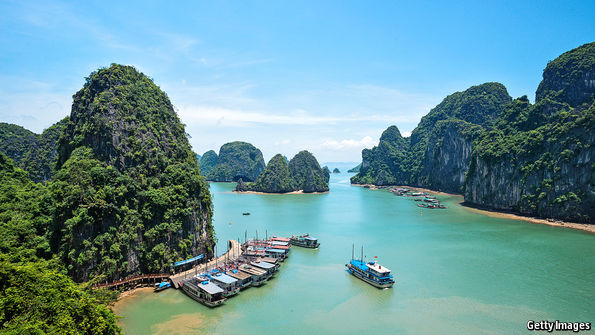 Spiritual nature
Spiritual nature Vietnam: A New History. By Christopher Goscha. Basic Books; 524 pages; $35. Allen Lane; £30.
WHAT do people think of when they see the word Vietnam? In America the name conjures images of a brutal, grinding military loss which, until President George W. Bush’s ill-fated decision to invade Iraq in 2003, made American leaders rightly hesitant to engage in wars of choice for ideological reasons. For young Europeans Vietnam has become an essential stop on the circuit of backpacking around Asia, offering pleasant weather, cheap accommodation, great food and just enough exoticism to give bragging rights at university and just enough tourist infrastructure to make travelling reasonably comfortable. Investors appreciate its cheap labour, long coastline, numerous ports and pro-business policies—all assets that will grow increasingly important as Chinese labour costs rise.
But Vietnam, today, is not the front-runner in any of those categories: China still draws more investment, Thailand more tourists and the ongoing Iraq fiasco more opprobrium. Ask the average Westerner to name a great Vietnamese artist, musician or writer—or a politician not named Ho Chi Minh—and you would probably get a blank stare in response. French politicians and writers in the 19th and 20th centuries saw Vietnam as a land first to subjugate and then to administer. Contemporary Western historians all too often see it simply as a victim of colonialism: a country to be pitied and ennobled, and with which greater powers had their way, rather than as a polity that has done what any other polity does: make the best of suboptimal situations.
Christopher Goscha’s thorough and thoughtful new history of Vietnam counters these simple portrayals with large and welcome doses of complexity. The area known today as Vietnam, he convincingly argues, was not just a blank mass awaiting modernity and the French (not necessarily in that order). Numerous political entities battled for influence, particularly in the fertile region along the Red river, which runs from Kunming (today in the southern Chinese province of Yunnan) into the Gulf of Tonkin, which sits between northern Vietnam and Hainan.
The Han Dynasty subsumed northern Vietnam into Imperial China in around 110BC. Chinese administrators waxed lyrical about the Red river area’s benefits as a trading post. Over the millennium of Chinese rule, what Mr Goscha calls a “Sino-Viet or Sinitic elite” emerged; not until the 20th century did quoc ngu, as Vietnam’s contemporary Latinate alphabet is known, displace the Chinese and indigenous character-based language as the standard written script. The Chinese influence on Vietnam still persists, notably in the Mahayana Buddhism which today is practised by many ethnic Vietnamese, and in Vietnam’s distinctly Confucian political and education systems. But Ngo Quyen routed the Chinese in 939AD, renaming the territory Dai Viet, or “Greater Viet”.
Dai Viet rulers then embarked on a grandiose imperial expansion; indeed, one of the signal achievements of Mr Goscha’s work is the attention he pays to pre-European South-East Asian imperialism. The French were just one of many groups to conquer and colonise the territory known today as Vietnam. They may not even have been the most successful. The Dai Viet used military might and Confucianist statecraft and administration to push the Viet empire southward, in order to “respectfully bring the Mandate of Heaven, and do the work of striking and killing those cruel people”. They then did what kings around the world had done: they invented a mythical past to justify their conquests. Viet generals known as the Nguyen pressed even farther southward, bringing their state with them. In the early 19th century Viet emperors declared themselves rulers over a unified (if fractious) state that included parts of modern-day Vietnam, Laos and Cambodia.
Thus when the French established their first colonial base of Cochin-China in 1862, they did not build a state so much as layer a French veneer onto an already functioning one. The Nguyens’ extensive land-registry records made it easy to collect property taxes; the French also drew revenue from state monopolies on alcohol, gambling, opium and rice production. Much as the British did in their South Asian possessions, the French adroitly exploited local grievances, propped up pliable rulers and developed an ethnic-Vietnamese colonial elite—all, of course, with the threat of violence in the background. The French conquest of Indochina was driven less by a civilising mission than by mercantile interests, particularly rubber, rice and coffee, all made into profitable exports by “cheap, mainly ethnic Viet sweat”.
After the first world war, anti-French pressure grew until Ho Chi Minh, whom Mr Goscha depicts less as a communist ideologue than as a crafty statesman, declared independence on September 2nd 1945. Decades of war followed. Today Vietnam, like China, has a booming economy, and remains communist in name only. The ruling party, as Mr Goscha notes in his shrewd final chapter, has subtly shifted its raison d’être “from defending ‘class struggle’ and ‘proletarian internationalism’ to promoting economic prosperity and inclusive nationalism for all social groups”. Ho would understand. He might even approve.